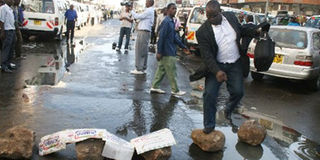Clogged sewers pose health risks to city residents

A man jumps over raw sewage along Accra Road, Nairobi. Broken sewers pose a great health hazard to city residents. PHOTO/FILE/WILLIAM OERI
What you need to know:
- Although the Nairobi County government is mandated to enforce construction laws, rogue developers continue to put up buildings in disregard of planning regulations.
- In other instances, the septic tanks overflow because they are too small for the flats they serve.
While the construction of high-rise residential buildings in Nairobi could be seen as the answer to the housing crisis, some of them pose a danger to the environment.
This is because they lack appropriate sewerage systems resulting in the disposal of waste water into open drains.
Although the Nairobi County government is mandated to enforce construction laws, rogue developers continue to put up buildings in disregard of planning regulations.
In effect, they end up choking the already overloaded sewerage system.
Dr Robert Ayisi, Nairobi County Director of Health says the broken sewers pose a great health hazard.
This is because spillage of waste water onto roads, houses and other places can result in disease outbreaks especially when it mixes with water intended for domestic use.
“During the rainy seasons, some of Nairobi’s estates are normally flooded with sewage because of the overflowing open manholes. Dumping of solid wastes in open manholes and construction of illegal buildings on sewer lines results in clogged systems which pour effluent into the streets,” he says.
TOO SMALL
In other instances, the septic tanks overflow because they are too small for the flats they serve. This is common in Nairobi’s Eastlands area.
It is predicted that the sewerage system will be clogged even more when the city’s population hits the projected 20 million mark by 2020.
Solomon Kioko, a planner, says the existing city sewer system built in 1961 was meant to serve less than one million people and is about 163 square kilometres.
“The sewer line is less than 30 per cent of the city’s total 696 square kilometres and only 20 per cent is connected to the sewerage system.
It is regrettable that planners make provision for sewer lines but developers ignore this and build on them. The result is the mess we now have,” says Kioko.
He says the new county government should act by fining developers who disregard the city planning department’s guidelines and demolish houses built on sewer lines.
In May, the Athi Water Services Board commissioned the construction of a new sewerage system in the city dubbed the Nairobi Sewerage Improvement Project.
Mr Malaquin Milgo, the Athi Water Services Board chief executive says the proposed project aims at expanding access to sewerage services to city residents from the current 40 per cent to 59 per cent by 2014
“The current sewerage system covers a mere 25 per cent of the area while serving only 40 per cent of the population. The three-year project will include rehabilitation and expansion of treatment plants, old trunk lines and laying of new ones in some areas with secondary and tertiary reticulation,” says Mr Milgo.
RIPARIAN RESERVE
He says the project will increase sewerage access coverage in Nairobi to about 50 per cent in the next five years.
The proposed trunk sewers of various pipe diameters are expected to cover about 60km within the riparian reserve of selected rivers in Nairobi area.
Last year, the National Environmental Management Authority (Nema) reined in on landlords in Zimmerman, Umoja, Embakasi, Mlolongo, Ongata Rongai and Dagoretti over poor drainage systems.
It ordered them to build septic tanks where there were none and expand capacities of small ones within one month.





